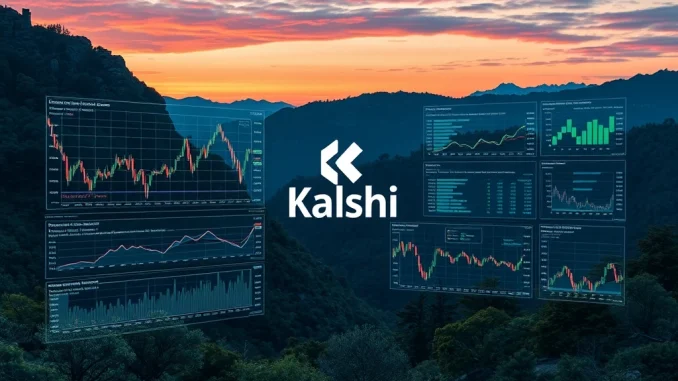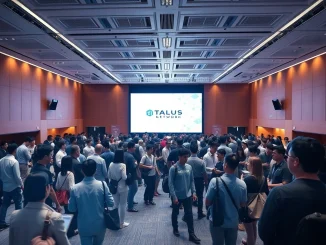
The world of prediction markets is buzzing with a significant development. Kalshi, a platform where users can bet on the outcome of future events, has announced a potentially game-changing collaboration. The platform is entering into a **Kalshi xAI partnership** with xAI, the artificial intelligence firm founded by Elon Musk. This move signals a deeper integration of advanced AI into the prediction market space, aiming to equip users with sophisticated tools for navigating complex event outcomes.
What Does This Mean for **AI Prediction Markets**?
Prediction markets like Kalshi allow individuals to trade contracts based on the probability of specific events happening. Think of it as a stock market for news, politics, science, and culture. Historically, traders in these markets relied on their own research, news analysis, and intuition to make informed decisions. The introduction of powerful AI changes the landscape significantly.
This partnership aims to leverage xAI’s capabilities to synthesize vast amounts of information – including news headlines, historical data, social media trends, and potentially other relevant datasets. The goal is to process this data at speed and scale, identifying patterns and extracting insights that would be challenging for a human trader to uncover alone. This integration pushes the boundaries of what’s possible in **AI prediction markets**, moving beyond simple data aggregation towards intelligent analysis and tailored insight generation.
The Power Behind the Partnership: Exploring **Elon Musk xAI**
xAI, founded by Elon Musk, has stated its mission is to understand the true nature of the universe. While that sounds philosophical, its practical application involves building advanced AI models capable of complex reasoning and data processing. Partnering with a firm led by Musk and staffed by researchers from deep AI backgrounds brings significant technological muscle to Kalshi.
The involvement of **Elon Musk xAI** lends credibility and access to cutting-edge AI technology. xAI’s models are being tasked with the crucial job of sifting through the noise of real-world information to find signals relevant to specific, tradable events on Kalshi. This could involve analyzing the nuances of Federal Reserve statements, tracking shifts in public opinion during election cycles, or evaluating the impact of new scientific discoveries on relevant markets.
How Will This Enhance **Trading Insights AI**?
The core benefit promised by the **Kalshi xAI partnership** is the delivery of tailored insights directly to users. Instead of just providing raw data, the AI will process information related to specific contracts and events, offering synthesized summaries or highlighting key factors that could influence the outcome.
Consider trading on the likelihood of a specific interest rate hike by the Federal Reserve. The AI could analyze recent economic data releases, public statements from Fed officials, market reactions, and historical patterns to provide a concise overview of the factors favoring or opposing a rate change. For election markets, the AI might analyze polling data, news coverage, candidate statements, and historical election trends.
Key enhancements to **trading insights AI** could include:
- Data Synthesis: Combining disparate sources of information into coherent summaries.
- Trend Identification: Spotting subtle or emerging trends missed by manual analysis.
- Information Filtering: Cutting through irrelevant noise to focus on critical factors.
- Contextual Analysis: Understanding the context and potential implications of news and events.
This doesn’t mean the AI will tell users exactly how to bet, but rather provide a more informed foundation upon which users can make their own decisions. It’s about empowering traders with better information, processed more efficiently.
The Future of **Prediction Market AI**
The collaboration between Kalshi and xAI represents a significant step in the evolution of **prediction market AI**. It moves the technology from being a peripheral tool to a central component of the insight generation process. If successful, this model could set a precedent for how other prediction platforms integrate artificial intelligence.
The potential applications extend beyond economics and politics to virtually any verifiable future event. As AI capabilities advance, the depth and breadth of insights available to prediction market participants could increase dramatically. This could lead to more liquid markets, more accurate aggregate predictions (as users are better informed), and potentially open up new types of events for trading.
It’s worth noting that Kalshi also has other notable connections, including being advised by Donald Trump Jr. This diverse set of advisors and partners highlights Kalshi’s ambition to position itself at the intersection of technology, finance, and public events.
Challenges and Considerations
While the potential is exciting, integrating AI into prediction markets isn’t without challenges. The accuracy of AI models depends heavily on the quality and completeness of the data they are trained on and the algorithms they use. Bias in data could lead to biased insights. Furthermore, the regulatory landscape for prediction markets and the use of AI in financial contexts is still evolving.
Ensuring transparency in how AI generates insights and managing user expectations about AI’s predictive power will be crucial for Kalshi.
Compelling Summary
The strategic **Kalshi xAI partnership** marks a pivotal moment for prediction markets. By integrating advanced AI from **Elon Musk xAI**, Kalshi aims to revolutionize how users gain insights, moving towards sophisticated **trading insights AI** derived from synthesizing vast data streams. This development underscores the growing role of artificial intelligence in financial and prediction-based platforms, potentially unlocking a new level of informed participation in **AI prediction markets**. While challenges remain, the collaboration signals a clear path towards a future where AI-powered analysis is central to predicting and trading on real-world events.



